Earth Flyby - BepiColombo Flyby
BepiColombo Earth Flyby
Information in a nutshell
| Date | 10 April 2020 |
| Time | 04:25 UTC |
| Purpose | redirect the spacecraft towards the inner solar system |
| Observability from Earth | the spacecraft is observable by telescopes south of +30 degrees latitude (also read: Heavens-Above and Info Page, use Flickr or Europlanet form to share your images) |
| Payloads Operated | MMO: MPPE, MGF, PWI MPO: ISA, MERTIS, MGNS, MORE, MPO-MAG, PHEBUS, SERENA, SIXS MTM: MCAM1/2/3 |
Planetary Flyby's: What you need to know
The first successful planetary flyby ever made was performed the 14th December 1962 by the Mariner 2 NASA spacecraft with the planet Venus, but it was with the Mariner 10 mission, thanks to an intuition of the italian Mathematician Giuseppe (Bepi) Colombo in 1970, that we use now the flyby as orbital correction maneuver. Indeed, the professor from Paduan was invited from the JPL to participate in a conference about the Mariner 10 directed to Mercury. When he observed the spacecraft computed orbit, he noted that the Mariner 10 would have an orbital period around the sun twice the Mercury year. Hence, he suggested to carfully calibrate the first passage over Mercury in such a way that the spacecraft would have exactly the delta velocity from the planet to re-encounter Mercury at the next revolution. His suggestion was fully accepted and, thanks to him, Mercury 10 (llaunched in the 1973 on its way to Venus) had its first flyby with Mercury on 5th February 1974, and a second a third flyby on 21th September 1974, and also a third on 16th March 1975. The change in trajectory found by Giuseppe Colombo allowed to greatly increase the scientific return of the mission, as well as the scientific knowledge of the planet Mercury.
The Interplanetary Cruise
Celestial mechanics and spacecraft navigation are basically a matter of energy.
In fact, a balance between the attraction of the bodies (the gravitational potential) and spacecraft velocities (the kinetic energy) is the crucial point to define a trajectory in space.
Nothing stands still, everything moves. Indeed, our Sun is orbiting around the center of the Galaxy (our Milky Way) respecting this balance: planets find their own equilibrium orbiting around the Sun and the same occurs for the moons, which find a balance with their own parent planets. In a similar way, a spacecraft travels in space following the trajectory described by this equilibrium. But the gravity of the far bodies does not disappear when moving closer to another. Hence, when dealing with the attracting force of many bodies, we can approach this problem by considering the most massive body as the central gravitational body, and the others as perturbations. We call sphere of influence of a body the portion of the space where the leading attracting force is the attraction of the body itself. For the Earth, this sphere has a radius of about about 1 million km and is defined as the region where the attraction of the Earth is greater than the solar attraction.
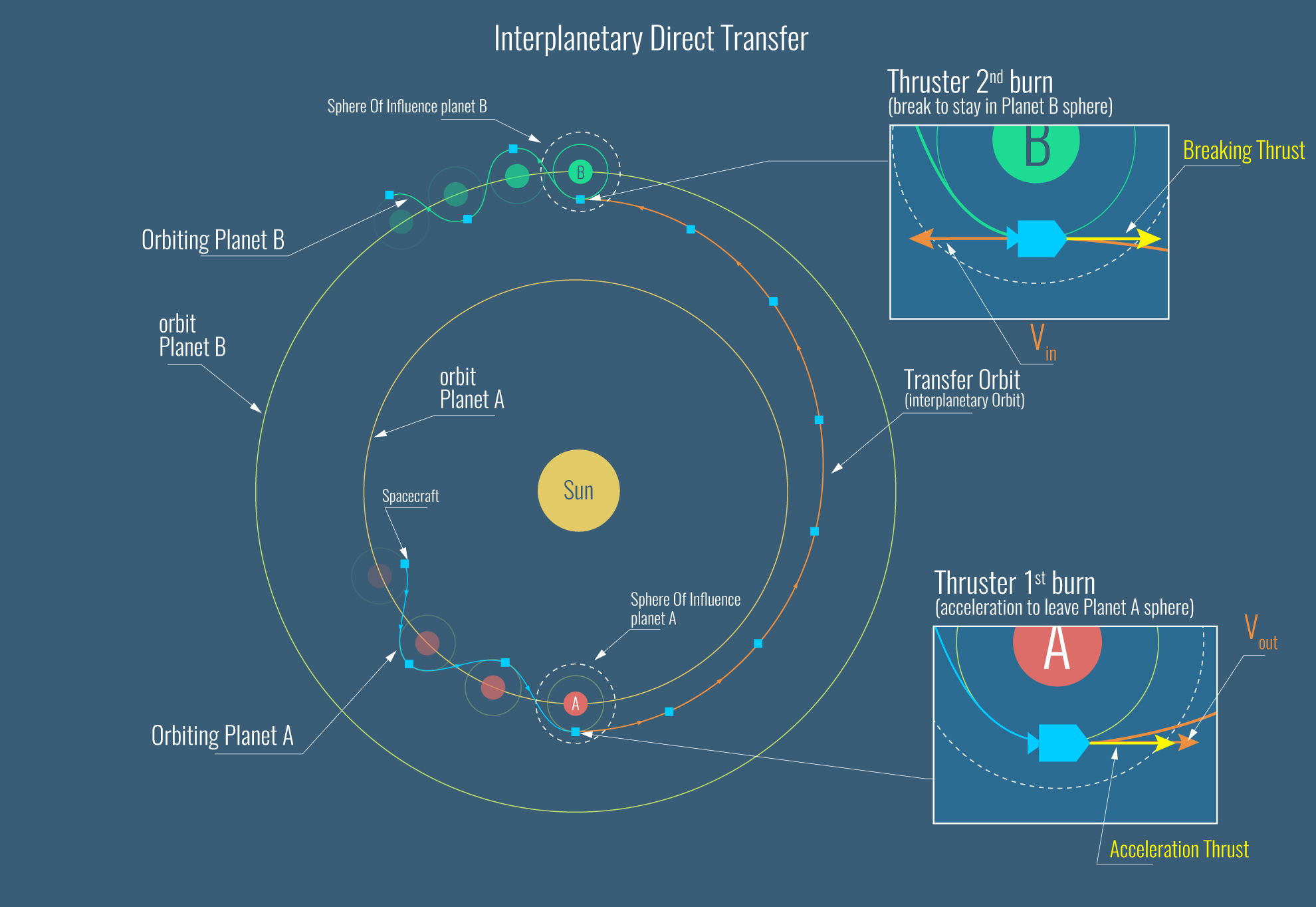
Such goal can be achieved with the use of a thruster. In fact, a thruster can change the spacecraft kinetic energy to let it move along a path closer or farther from the attracting body. Nevertheless, the use of thrusters requires propellant and, hence, would increase the mass of the spacecraft itself. The second law of mechanics says that the higher is the mass of a body, the higher is the force needed to change its velocity. This means that use of propellant should be minimized; instead a trade-off is needed.
ESA's flight dynamics team is in charge to find and optimise the trajectories to find the best trajectory that allows a spacecraft, with a given mass and velocity, i.e. to move from a point A to a point B in space, when we want to move the spacecraft outward in the Solar System (see Figure 1).
How a Flyby works
Since a spacecraft is constrained in terms of mass at launch, it cannot host more than a given amount of propellant and, in general, covering the distances between planets would require a huge amount of propellant. This is the reason why using the planetary flybys is a very smart solution to overcome the unavoidable mass constraints at launch.
When a spacecraft enters and exits from a planetary sphere of influence, its energy with respect to the planet does not change, while it changes with respect to the Sun. Indeed, during the approach, an exchange of energy with the planet occurs: the spacecraft kinetic energy progressively increases to a maximum (named ‘closest approach’, or CA), while at the same time the gravitational potential energy decreases. The opposite happens when the spacecraft departs from the planets. However, the spacecraft velocity relative to the planet is the same at the arrival and departure; while the spacecraft velocity relative to the Sun is increased or decreased depending on the geometry of the approach. Of course, the energy conservation law is is still valid: hence, the kinetic energy gained by the spacecraft (in terms of velocity) during the flyby is lost from the planet, since its velocity is decreased during the flyby with respect to the Sun (but, as the mass of the planet is a factor 1021 bigger than the satellite mass, the change in velocity is negligible and not clearly visible).
Finally, when the spacecraft arrives at the target planet orbit, a specific manoeuvre near the planet can modify the spacecraft interplanetary orbit by simply gaining/losing kinetic energy from/ to the planet.
Flybys can be used in both directions, to increase or decrease the velocity of the spacecraft. To decrease energy is a way to decrease the semi axis major of the orbit, that means to design a closer trajectory the central body. On the other hand, to get energy means to increase the semi axis major so to move away from the center body (see figures below).
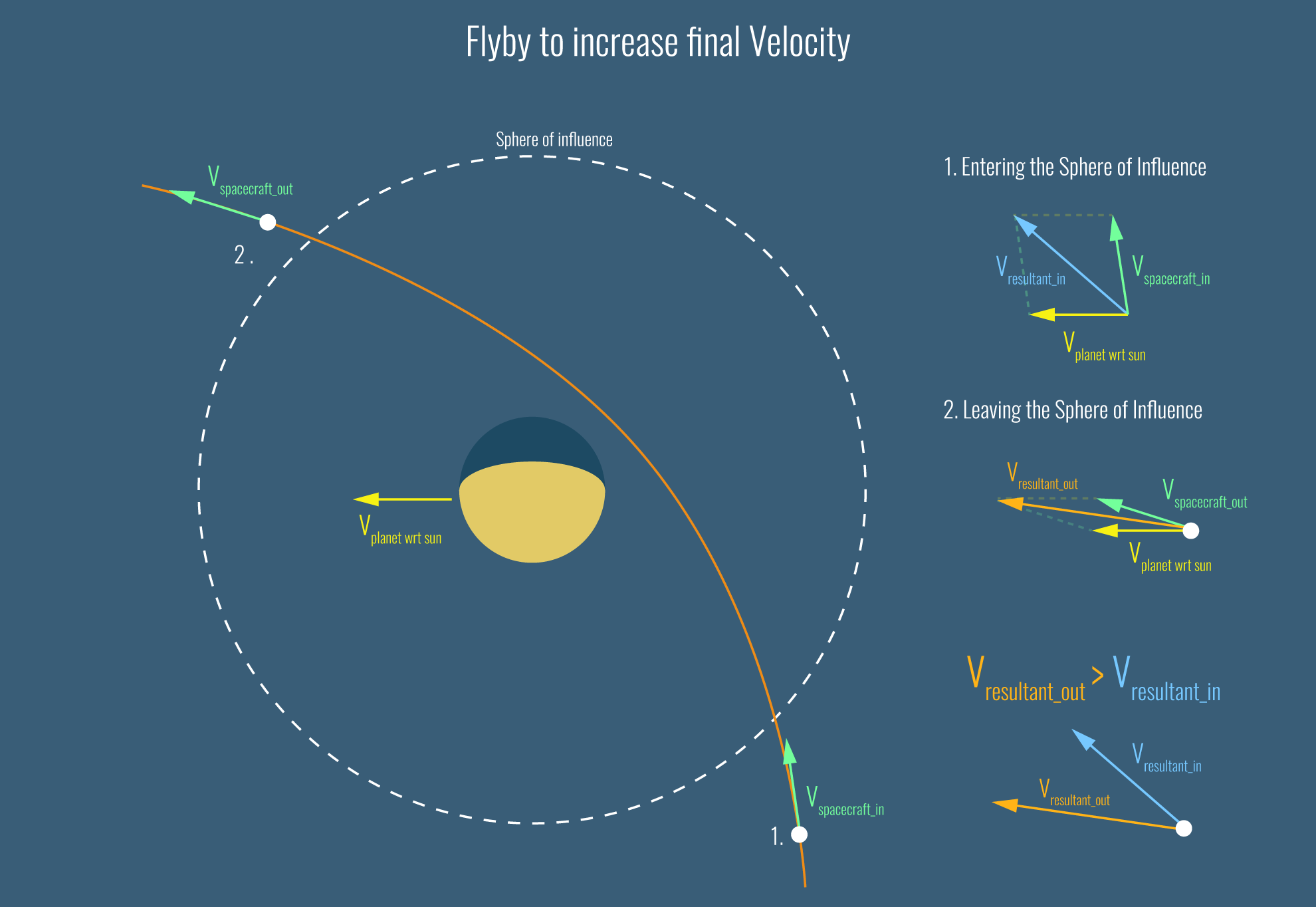
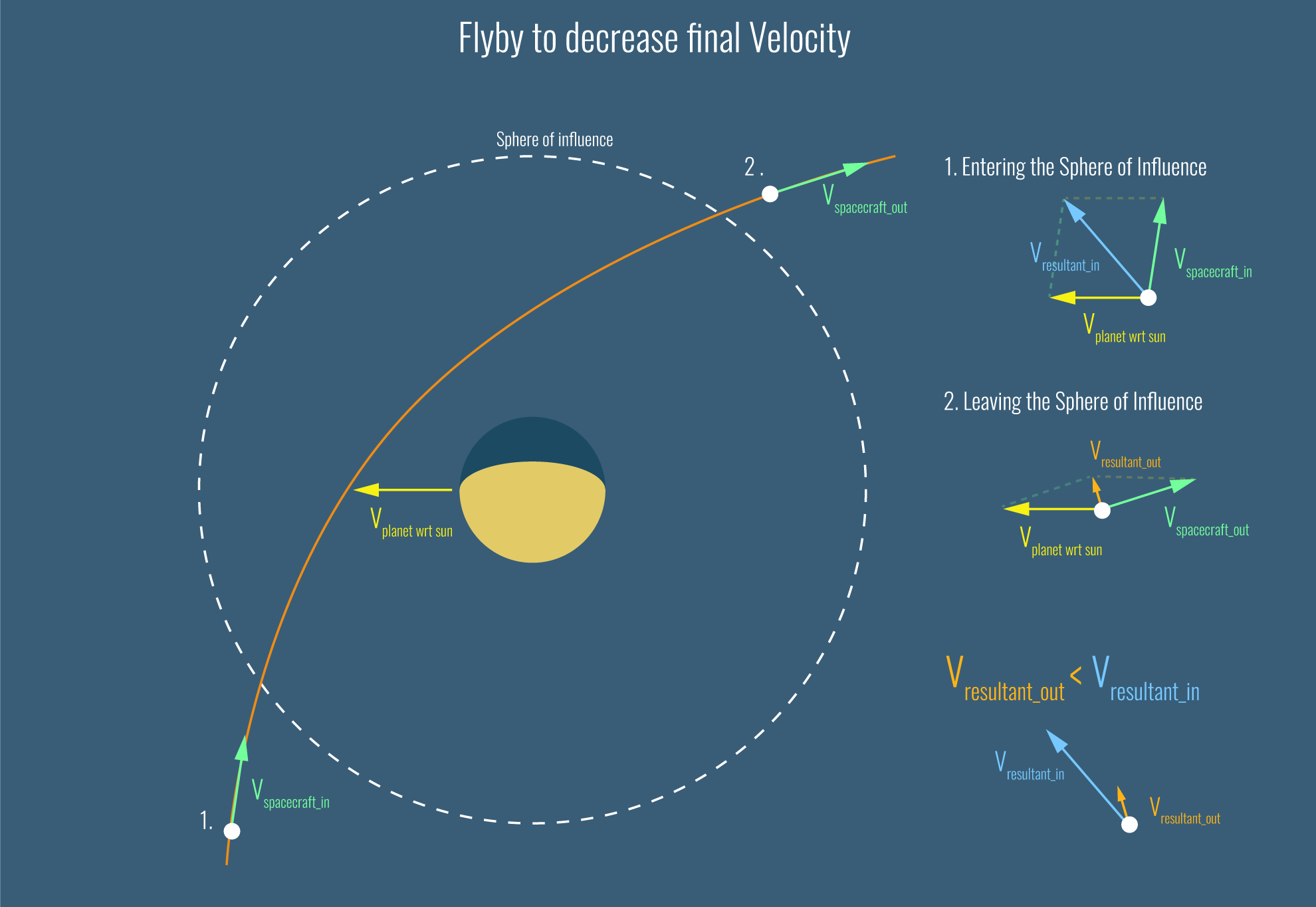
The spacecraft BepiColombo on its long way to Mercury will perform 9 flybys: the one at the Earth is just the first. It will be followed by two at Venus (in October 2020 and August 2021), and 6 at Mercury, starting from October 2021, before orbit insertion in December 2025.
The BepiColombo Earth Flyby
When BepiColombo will approach the Earth on 10 April 2020, it will fly in “front” of the Earth (see figure above) and approach the Earth eastward, and moving westward. This is because the spacecraft need to reduce its energy and change its trajectory to move toward the inner Solar System, getting the trajectory that will bring the spacecraft to Venus, for its next flybys in October 2020 and August 2021.
In terms of velocity, BepiColombo will loose about 5 km/s with respect to the Sun.
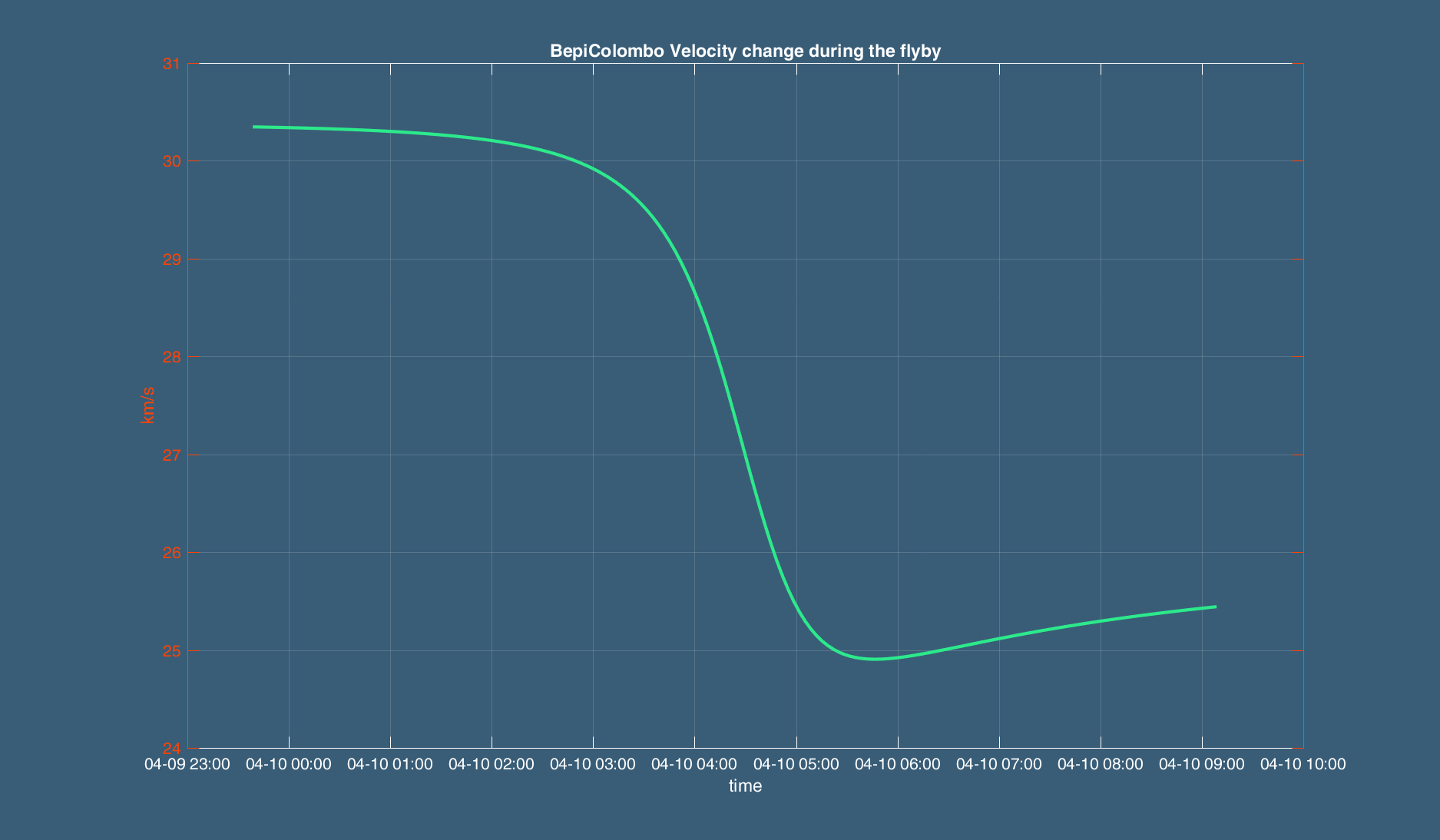
This means, using the Tsiolkovsky rocket equation:
mini=mfin•exp(V/(Isp•g0))
Where mini and mfin are the spacecraft mass at beginning and after the thuster burn. Considering that BepiColombo mass is 4000 kg mass and the even very efficient ion thrusters specific impulse Isp is 4300 s, the equation says that this maneuver saved about 450 kg of propellant (Xenon)!
BepiColombo Earth Flyby: The whole flyby scenario
To achieve the goal of the flyby, several trajectory correction manoeuvers (TCMs) are executed in the weeks before the flyby, and one manoeuver after the flyby. These manoeuvers are based on the chemical propulsion system of the Mercury Transfer Module (MTM), with the exception of the last manoeuver that is using the solar electric propulsion system (SEPS). During the flyby, no thrusters are operated and gravity plays its cards.
An orbit determination was executed on 15 February 2020, followed by a 1st TCM on 26 February 2020 ,12:00 UTC. A transversal velocity change of 34.7 cm/s was applied, ensuring the Earth flyby distance of 19064 km (from the Earth center) at a flyby time of 04:25 UTC. The first TCM moves the closest approach distance by about 1289 km away from the Earth center. All the TCMs executed are not targeting the parameters of the next flyby only, but of the whole BepiColombo cruise phase until Mercury orbit insertion. After the TCM, the success of the TCM was confirmed with an accuracy of 1%.
On 5 March 2020 an orbit analysis has been done with the conclusion that the current BepiColombo orbit is very well within expectations. A planned TCM on 12 March 2020 will not be necessary anymore and thus not be scheduled.
Another orbit analysis from 19 March 2020 concluded that also the 26 March 2020 trajectory correction manoeuvre is not neccessary as the current trajectory is good. The next orbit analysis was done on 30 March 2020, again confirming that the flown orbit is well within the expected error ellipses: thus the TCM scheduled for 4 April was not needed.
BepiColombo is on-track for the flyby.
After the flyby, on 23 April 2020, the fist post-Earth-flyby TCM is scheduled.
Observability from Earth
On the early morning of the 10th of April, there will be the possibility, hopefully, to observe the crossing on the sky of BepiColombo spacecraft crossing the sky from East to West. The closest approach is foreseen at 04.25 UTC with a minimum distance of 12.677 km from the Earth’s surface.
If you want to compute your own plot for your location by inserting latitude and longitude here: https://bepicolombo.iaps.inaf.it.
Another interesting page not to miss is the one from Heavens-Above.
Observers at latitudes close to the equatorial ones, especially in the southern hemisphere, will be favoured in terms of elevation on the horizon and of apparent magnitude. Unfortunately, the Moon will be very bright in the night sky and may challenge observations from Earth. However, amateur astronomers, astronomy-addicted people, astro-photographers and curious people are invited to accept this challenge, trying to catch the passage of BepiColombo with their telescopes, binoculars and cameras.
In fact, on the morning of April 10th the sky will already show a beautiful triple large conjunction in the sky area crossed by BepiColombo. Over the local horizon (with differences depending on the location of the observer) Jupiter, Saturn and Mars will be aligned with an angular separation of about 5° 45’ between Jupiter and Saturn, and about 6° between Saturn and Mars. Their magnitudes will be relatively high, allowing to see them by naked-eye, not only under dark skies but also from the cities. Jupiter, the brigther, will show an apparent magnitude of -2.2, whereas Saturn and Mars will shine around +0.6.
The possibility of making a nice picture on a large field of view with a triplet of very famous planets, Jupiter, Saturn and Mars, and the crossing of BepiColombo is a good motivation and an opportunity that cannot be missed. The estimated apparent magnitude of BepiColombo will be around m = 8, in the best conditions, hence, it will be not visible by naked-eye (limit magnitude around m = 6). However, with the right instrument and with the proper in-time preparation, it will be possible to get a picture of the event.
In the following figure the variation of the estimated apparent magnitude of the BepiColombo spacecraft is plotted versus different Earth regions, with a minimum value reached in the red-coloured regions. Latitudes around the equator and in the southern hemisphere are favoured in the observation.
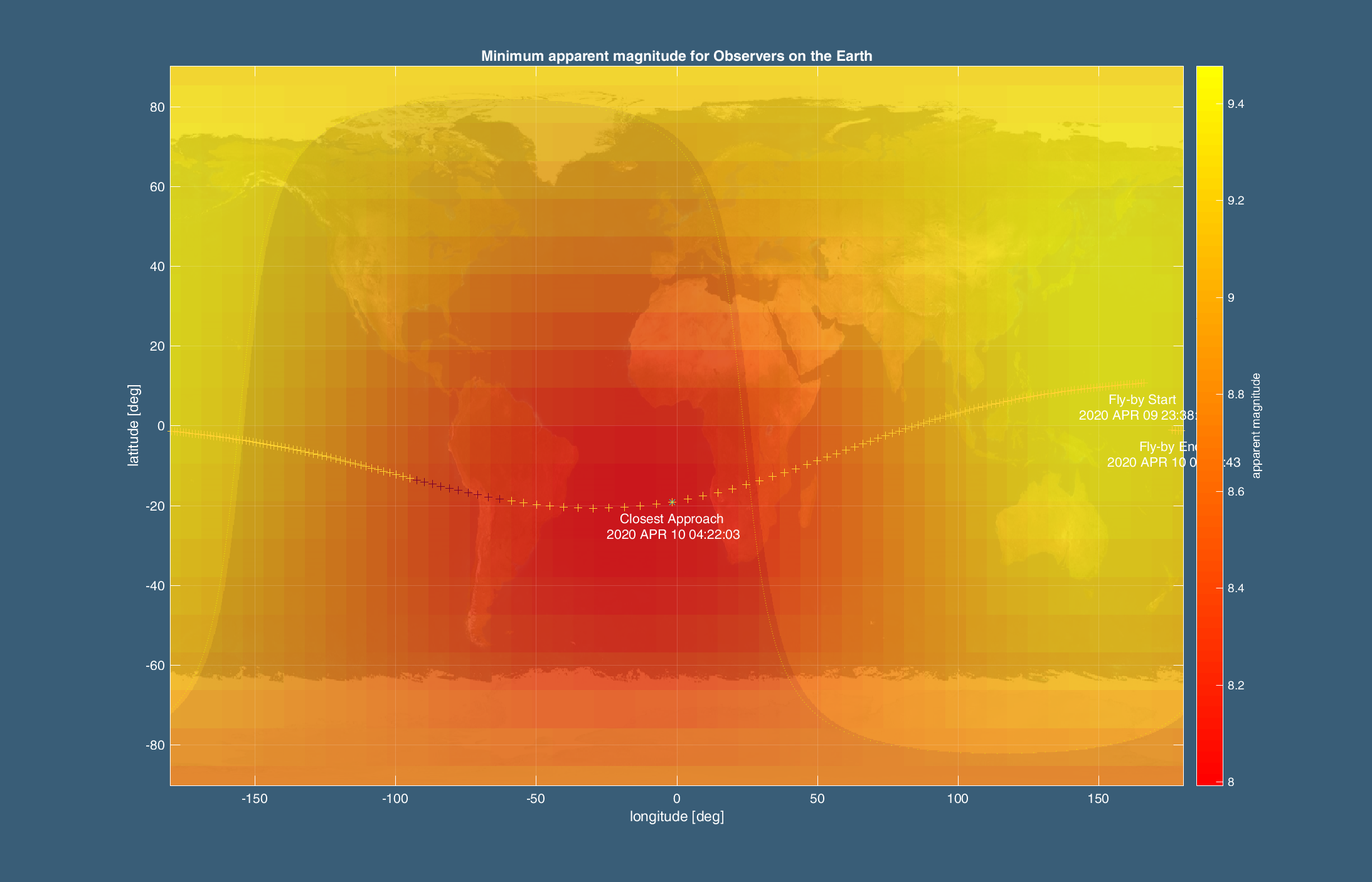
Variation of the apparent magnitude of BepiColombo spacecraft for different areas of the Earth. As shown by the legend, red-couloured areas are favoured for the observation since the apparent magnitude reaches a maximum value of m = 8.
The possibilities to observe or photograph the event are better for people living under skies far from big cities (hence darker) and at high-altitude places (mountains, hills). Observers with telescopes (for instance the classical 114 x 900 mm and higher), some medium-high size binoculars (7x 50, 10 x 50 and higher) and cameras should have better chance to observe the passage. However, these are general hints since the observation is subjected to many variables, starting from a nice meteorological weather and seeing to the observer conditions.
Estimation of the apparent magnitude of a spacecraft is not an easy task since it depends on several factors, first of all from the solar phase angle. Phase angle is the Sun-spacecraft-Earth angle. Solar panel size, direction and albedo contribute the most to determine the visual brightness of the spacecraft because they reflect towards the Earth part of the radiation while they are pointed to the Sun. How much of this radiation is sent to Earth is a function of the solar phase angle. Other factors affect the luminosity, such as the reflectivity of the materials composing the spacecraft and its components.
In the following, details on the observability conditions from some locations are reported and analysed. In particular, Rome (Italy), Cebreros (Spain), Cape Town (South-Africa) and La Palma in the Canary islands (Spain) have been chosen. Data of the event have been computed by using the SPICE Kernels of the BepiColombo mission (BepiColombo Dataset v221 -- Planning 20200311_001, https://www.cosmos.esa.int/web/spice).
The following table reports the main details of the BepiColombo flyby as seen from the different observers on the Earth, as analysed above.
| Site | Rise (UTC) | Set (UTC) | Max elevation (degrees) | Azimuth (degrees) | Time @ max elevation (UTC) | Minimum distance (km) |
|---|---|---|---|---|---|---|
| Rome (Italy) | 02:54:31 | 04:35:08 | 15.29 | 154.69 | 03:58:24 | 17.002 |
| Cebreros (Spain) | 03:33:28 | 04:50:23 | 11.88 | 165.63 | 04:15:55 | 16.761 |
| La Palma (Canary islands/Spain) | 03:46:53 | 05:20:53 | 23.20 | 177.96 | 04:30:43 | 15.642 |
| Cape Town (Soutd-Africa) | 02:45:18 | 05:03:17 | 64.45 | 349.58 | 04:11:46 | 13.405 |
Payload Operations During the Flyby
The launch and cruise configuration of BepiColombo MCS (Mercury Composite Spacecraft) will not allow full operability of all instruments onboard. In fact, on-board the European spacecraft MPO (see figure above) few instruments are obstructed by the MTM (+Z axis) and will not be able to operate. Nevertheless, all the other instruments not requiring pointing or with apertures in the other directions will be switched on. They are:
- ISA, the spring accelerometer,
- MERMAG, the two fluxgate magnetometers, on the boom
- MERTIS, the IR spectrometer and radiometer,
- MGNS, the suite of gamma ray and neutron monitors
- MORE, the radio science experiment
- PHEBUS, the suite of UV spectrometers
- SERENA, the suite of ion and neutral particles sensors (only the ion sensors)
- SIXS, the X-ray and high energy particle detectors
Plus:
- BERM, the radiation monitor
- MCAM (CMS), the three cameras located on the MTM module, with the goal to monitor the spacecraft appendages and try to image the Earth, the Moon, Venus and Mercury during the flybys.
(image by PICAM team at OEAW/IWF, Austria)
The Earth flyby is an opportunity to operate the above instruments of the BepiColombo spacecraft, mainly for calibrations purposes. The geometry of the flyby offers a very close approach to Earth surface (i.e., <13.000 km), while the Moon will stay rather far away from the spacecraft (i.e., >300.000 km) in the opposite direction. The Earth-Moon system is often observed by planetary missions cruising through the Solar System as it offers opportunities to operate the instruments towards targets, which are better known than the main objective of the missions itself. Nonetheless, those calibration observations may sometimes result in new scientific discoveries, as it already happened in the past.
In the present case, both MERTIS and PHEBUS will observe the Moon before and after the closest approach (CA).
MERTIS will obtain the first hyperspectral data of the Moon in the thermal infrared from space. Apart from using this for validating the calibration of the instrument, it will also provide an interesting new science dataset for the lunar science community and a baseline for the comparison with the future Mercury datasets.
PHEBUS will also observe the Moon, in two time slots after the CA with the purpose of checking the absolute calibration of its FUV channel and characterize the pixel to pixel sensitivity of the two detectors (flatfield correction). These data will be compared to previous observations of the Moon in the UV range.
The magnetometer MERMAG, will continue sampling the environment, as it is doing since the beginning of the mission, and it will provide measurements of the interplanetary magnetic field in the solar wind, as well as measurements of the Earth magnetosphere, from the crossing of the bowshock until the exit at about 20 hours later CA.
Ionised particle detectors like the PICAM and MIPA sensors of SERENA package, as well as the SIXS sensors with X rays and particle detectors, will complement the above measurements by sampling the high energy proton and electron population and X-ray spectrum within the FOV of the detectors shortly outside and inside the magnetosphere. In particular, SERENA PICAM and MIPA will also cross calibrate with each other by mean of the known populations and energies known to be present in the different regions, i.e. upstream Solar wind and Magnetosheath (where H+ and He+ ions are in the energy range of the instrument), and Plasmasheet (where O+ are potentially detected); but will be switched off when passing through the radiation belts to avoid the highly energetic particles.
The ongoing ISA accelerometer measurements, which also started since the beginning of the mission, will hopefully add information on the magnetospheric boundary crossings by trying to detect the variation of the charged drag (on MCS) due to abrupt change of particle density.
Thanks to MORE, also operative since the beginning of the mission, the real spacecraft trajectory will be tracked also during the Earth flyby, thus collecting data to possibly better model the spacecraft orbit and improve the orbit determination codes, and maybe add some knowledge on the ‘Earth flyby anomaly’. For reference information, please read "Rosetta Navigation at its First Earth Flyby".
Finally, the neutron and gamma-ray measurements of MGNS during Earth flyby should also contribute to the investigation of interaction between solar wind and Earth environment, as well as studies of spacecraft neutron and gamma-ray background upon its passage through the Earth's radiation belts.
In addition to the MPO spacecraft, also some instruments onboard the Japanese spacecraft Mio will operate, though partially obstructed during cruise phase by the sunshield MOSIF. They are: the plasma particle sensors MPPE-MSA, MEA, MIA HEP-ele and ENA, the magnetometer MGF, and the magnetic waves sensor PWI.
The information above is provided and maintained by C. Magnafico, V. Mangano, J. Benkhoff, and J. Zender.
For further information please contact the authors to the following email address
Other interesting reading ...
[01] https://scilogs.spektrum.de/go-for-launch/bepicolombo_swingby/
[02] "Rosetta Navigation at its First Flyby", by T. Morely and F. Budnik
[03] HeavensAbove Information Page
- Removed a total of (10) style text-align:center;
- Removed a total of (15) style text-align:justify;
- Removed a total of (1) align=center.








































 Sign in
Sign in
 Science & Technology
Science & Technology